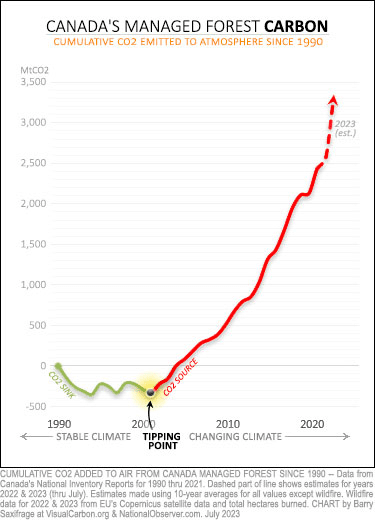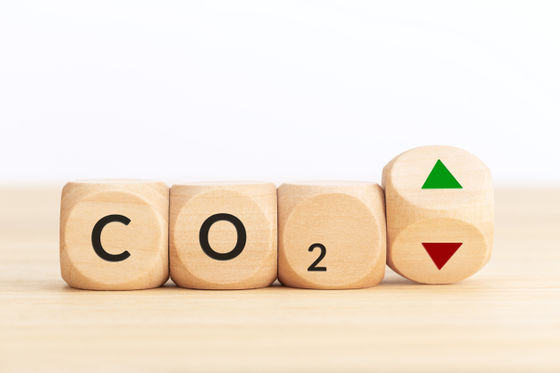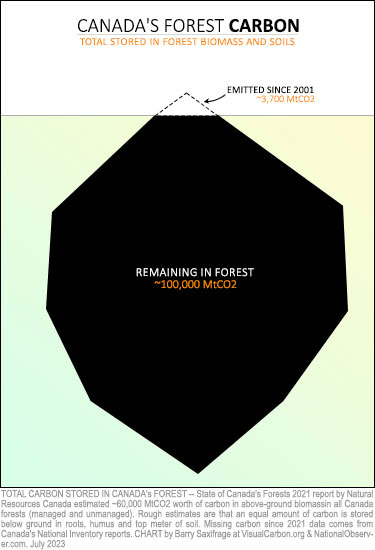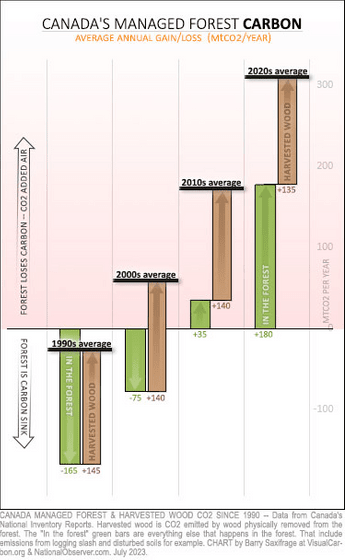``The era when forests absorbed carbon dioxide is over,'' says an expert, and climate change has turned forests from a carbon sink to a source of emissions.

Japan has approximately 25 million hectares of forest, which is equivalent to two-thirds of the country, but Canada, which boasts the third largest forest area in the world, has even more forest, approximately 347 million hectares. There is a common belief among Canadians that ``vast forests offset carbon dioxide emissions,'' but due to climate change, the function of forests to absorb carbon dioxide has reached a turning point. data was reported.
Our forests have reached a tipping point | Canada's National Observer: News & Analysis
In Canada, where forest fires are common, carbon dioxide emissions in 2023 are expected to double from previous years, but carbon dioxide emissions have actually been increasing rapidly in Canada for about 20 years. I did.
The figure below shows the total amount of carbon dioxide released into the atmosphere by Canadian forests from 1990 to 2023, based on data from the Canadian government and the European Union's Earth Observation Program. . Up until around 2000, forests were absorbing carbon dioxide, but around 2001 they switched from absorbing to releasing carbon dioxide, and the amount of emissions has increased rapidly since then.

Please note that the Canadian government only tallies emissions from 'managed forests,' which account for two-thirds of all forests, so the data for the remaining one-third is not included in the above chart.
Since the turning point in 2001, Canada has continued to emit more carbon dioxide than it absorbs for 22 consecutive years, with an average of 175 MtCO2 (megatons CO2) of carbon dioxide entering the atmosphere annually in the 10 years since 2010. released.
According to Canadian news media Canada's National Observer, it is not enough to offset this increase in carbon dioxide emissions by shutting down all gasoline-powered cars in Canada and stopping all households from using natural gas. .
'There's a feel-good myth in Canada that our vast forests offset some of our fossil fuel emissions,' said Barry Saxifridge, climate analyst at Canada's National Observer. This may have been true decades ago when the climate was stable, but as we weakened forests through decades of logging and fossil fuel-induced climate change, 'Forests now emit carbon dioxide instead of absorbing it.'

The problem isn't just the carbon dioxide already released into the atmosphere. Billions of trees grow on hundreds of millions of hectares of land, and according to Natural Resources Canada, above-ground biomass alone stores enough carbon to produce 60,000 MtCO2 of carbon dioxide. It is said that it is. Since roots and soil contain a similar amount of carbon, Canadian forests hold the equivalent of 100,000 MtCO2 of carbon.
Below is a diagram visualizing the amount of carbon stored by forests and the carbon dioxide released so far. Compared to the 100,000 MtCO2 of carbon depicted as a gigantic mass beneath the water surface, it is intuitive that the approximately 3,700 MtCO2 of carbon released into the atmosphere since 2001 is just the tip of the iceberg.

Forests, which store carbon, have functioned as a gift of nature that brings abundant fruit and energy to mankind, but now that they have begun to emit carbon dioxide, they will no longer be considered a 'carbon storage' but a 'carbon storage'. There is a risk that it could become a 'bomb' and threaten the natural environment and humankind.
As pointed out by climate analyst Saxifridge, logging and climate change are thought to be the causes of this shift in forests from carbon sinks to carbon sources.
Below is a diagram showing the increase and decrease in carbon dioxide emissions from managed forests in Canada, divided into those inside the forest (green bars) and outside the forests (brown bars). In the 1990s, the carbon dioxide absorbed by forest growth was balanced by the carbon dioxide emitted by logging, and carbon neutrality was almost achieved. However, in the 2000s, emissions began to exceed absorption, and since the 2010s, in addition to increased emissions from logging, large amounts of carbon dioxide have been generated from both inside and outside forests due to wildfires, thawing of frozen ground, etc. became.

Canada's National Observer sounded the alarm about the current situation in Canada, but it was reported that in 2021, even in the Amazon rainforest, carbon dioxide emissions exceeded absorption, and climate change has halted photosynthesis in plants. Furthermore, there is a strong need for global efforts to prevent the vicious cycle of increasing carbon dioxide emissions.
Climate change finally causes carbon dioxide emissions in the Amazon rainforest to exceed absorption - GIGAZINE

Related Posts:
in Science, Posted by log1l_ks







